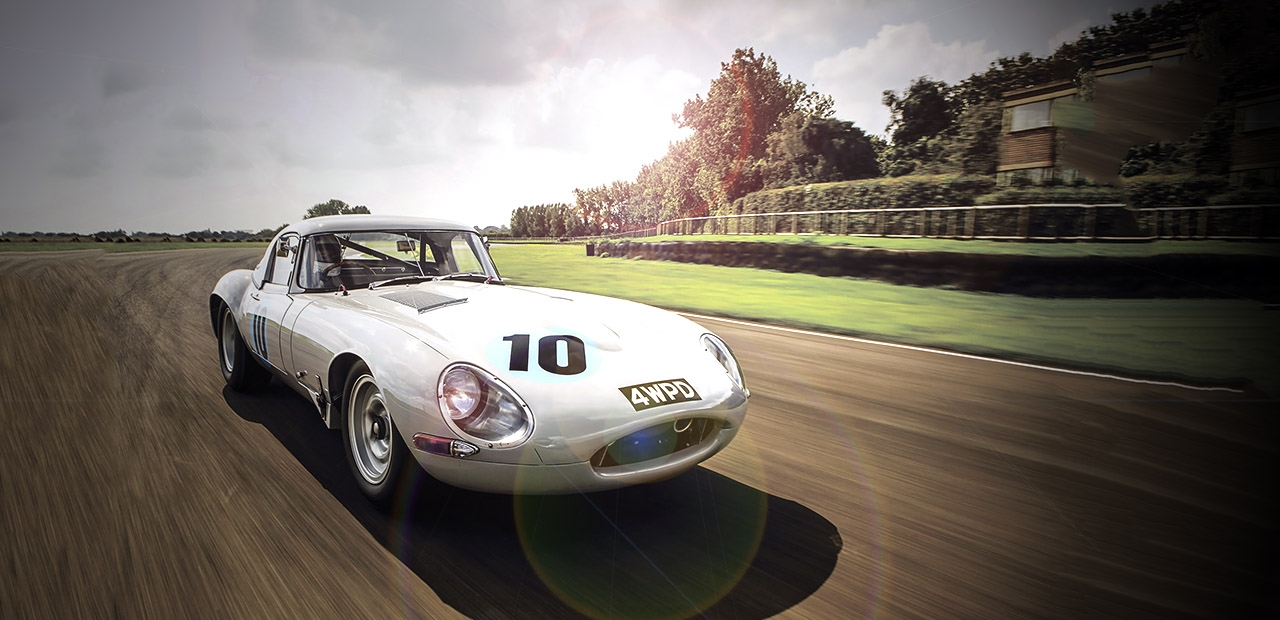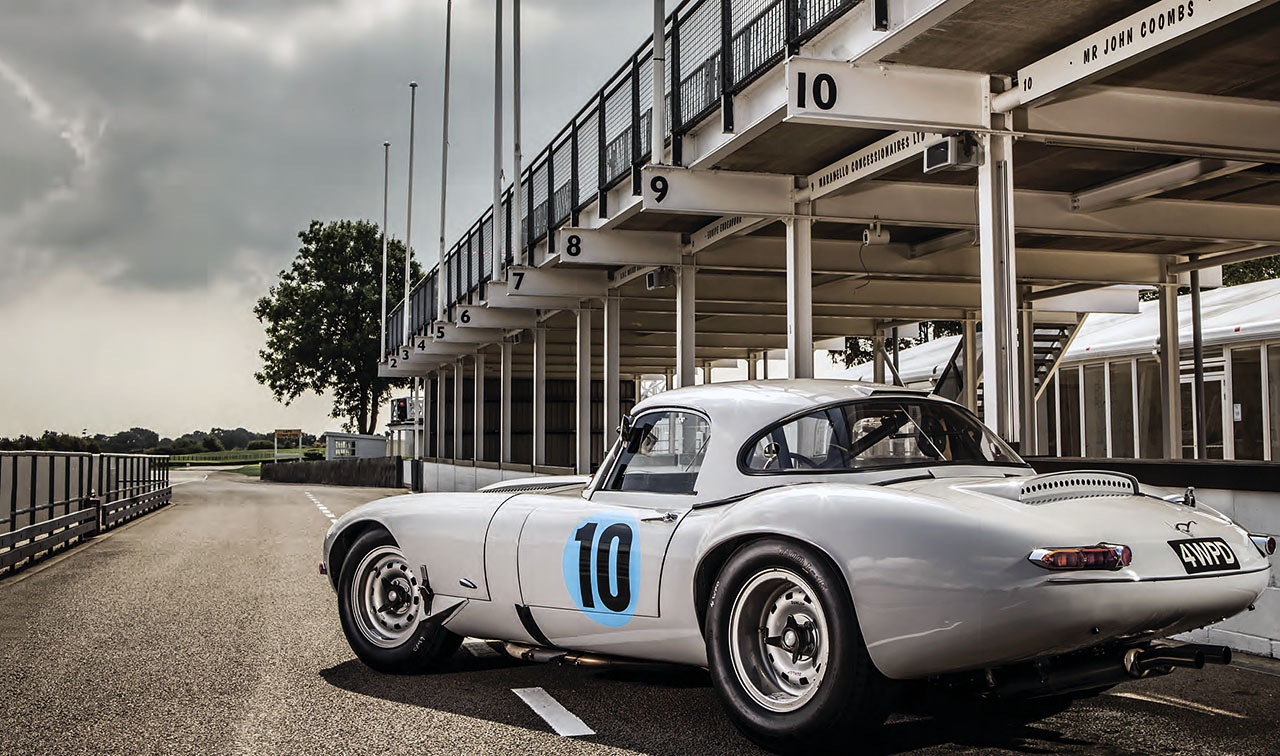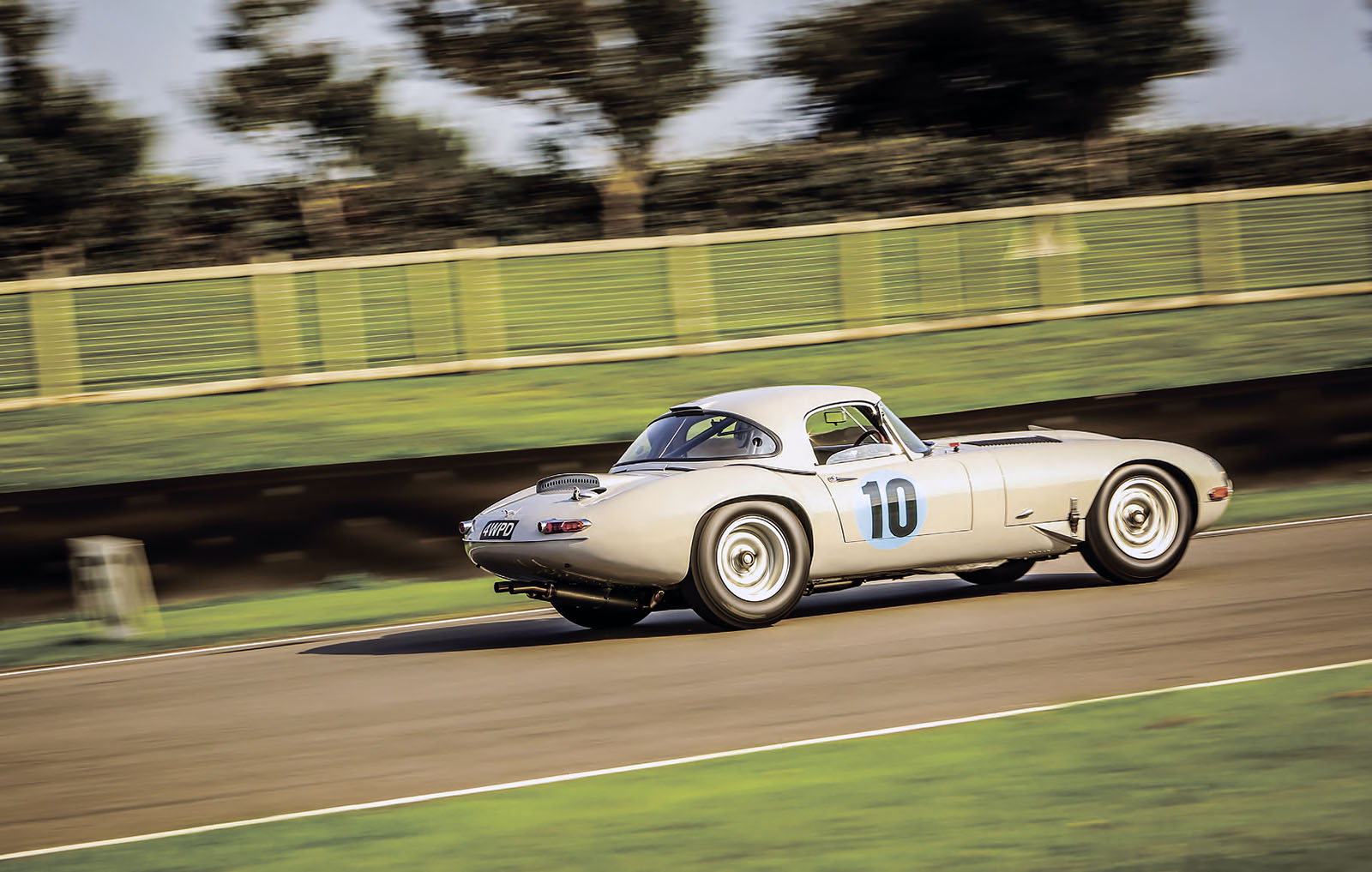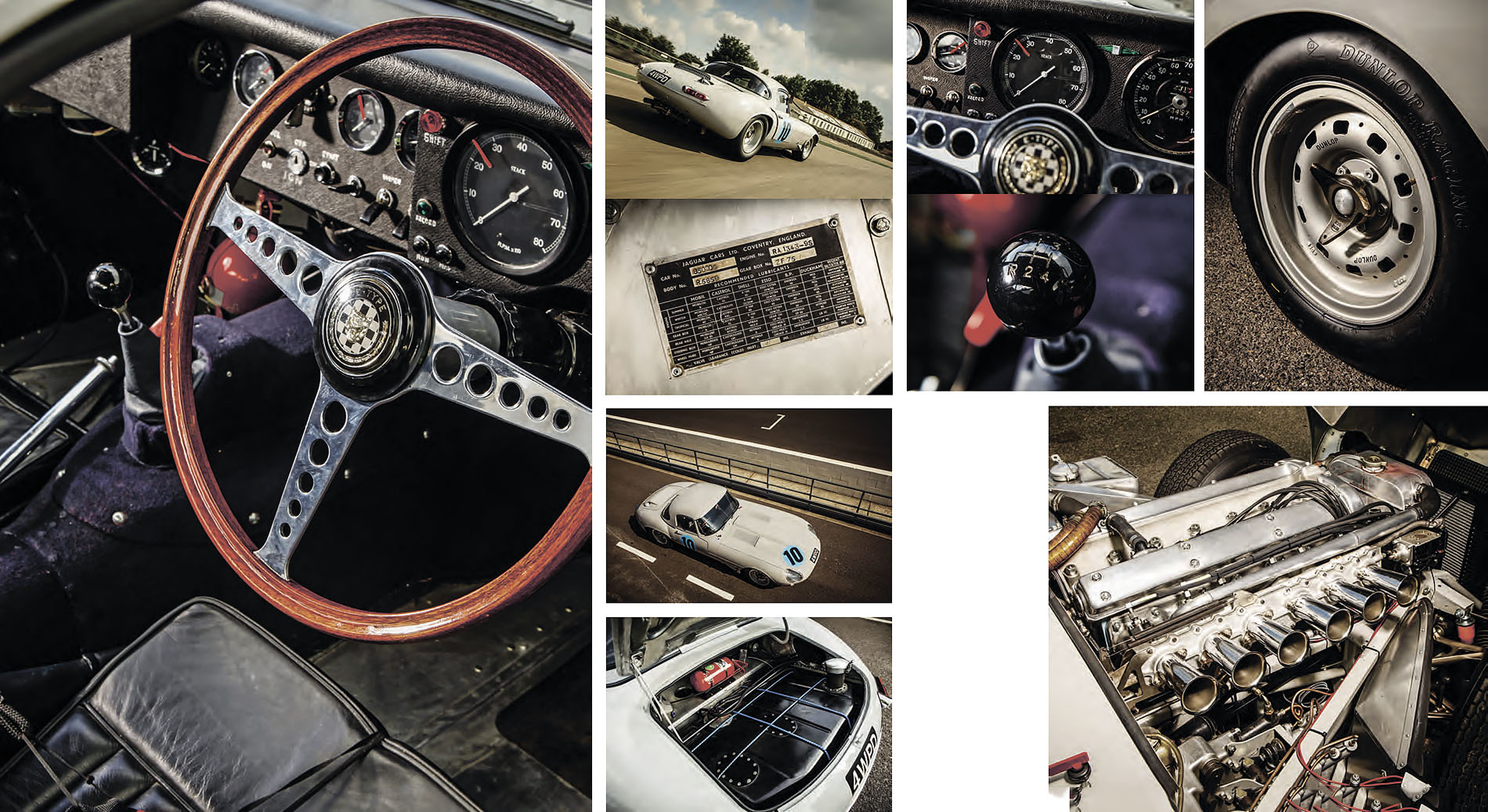
Jaguar’s Greatest E-type. Jaguar E-type Lightweight. Not just any Lightweight, but ‘4 WPD’, the very first. At Goodwood. Glorious. A thrilled James Page puts the most famous Lightweight of all – the legendary 4 WPD – through its paces at Goodwood. Photography Tony Baker.
Final instructions as I’m belted in place: don’t snap the throttle open – feed in the power gradually. And keep an eye on the fuel-pressure gauge – the injectors need a certain flow to operate properly. The last thing that anyone wants is for it to run lean and hole a piston.
Turn the key and prod the starter. The straight-six bursts into life and, with a slam of the driver’s door, I’m on my own. Slide down the Perspex window a touch, and glance at the dials. Everything seems healthy in the remarkably standard-looking interior, which – unexpectedly for a car that is still raced hard – has even retained its thin, wood-rimmed steering wheel.

There isn’t much track-time left, perhaps enough for only a few laps. The pitlane marshal waves me forwards. Select first, release the surprisingly light and forgiving clutch, and accelerate towards Madgwick.
Short-shift at first, gently through the righthander, then slowly open the throttle all the way for the run to Fordwater. Fuel pressure seems okay. On to St Mary’s and Lavant, then full throttle again for the main straight. I’d been warned that the brakes aren’t the car’s strong point, so I back off early for Woodcote and then ease through the chicane.
Full power and more revs past the famous pits – the acceleration just builds and builds. It’s relentless. Into Madgwick a little faster, and it’s easy to feel the E-type coming alive beneath you. It’s beautifully balanced, light, predictable and friendly at these modest speeds. To push harder, you would need to be comfortable with it sliding around – a handful of laps at somewhere as unforgiving as Goodwood is neither the time nor the place to do that with someone else’s hugely valuable motor car.
Brake a bit later for St Mary’s, and blip the throttle for the downshift. The pedals are set up beautifully for it, the engine response instant. I’m holding the gears longer now, letting the straight-six bark a little louder. Deeper into Woodcote this time, and on to another lap. Another glance catches the fuel-pressure gauge reading beneath the tell-tale. Next time around, I peel off into the pits. The temptation is to press on, push harder, but the overwhelming priority is to hand the car back in one piece. It’s been a brief encounter, but what a privilege to drive 4 WPD, perhaps the greatest E-type – and at Goodwood, of all places. It takes a long time for the buzz to wear off.
The story of this car goes back to the beginning of E-type production. While Jaguar was preparing for the Geneva launch in March 1961, ‘Lofty’ England drew up a list of buyers for the earliest production examples: number one was to be standard and for England himself; second and third on the list were cars with ‘engine mods’ for Tommy Sopwith and John Coombs respectively. Coombs owned a Jaguar dealership in Guildford, and had entered Mk1s and Mk2s for drivers such as Roy Salvadori and Graham Hill. Both E-type roadsters – Sopwith’s registered ECD 400, Coombs’ initially as BUY 1 – left Browns Lane in April 1961. Their first showdown was at Oulton Park, with Sopwith’s Equipe Endeavour car coming out on top thanks to Graham Hill. The Coombs E-type, driven by Salvadori, finished third after its brakes faded towards the end. Despite competition that included Jack Sears in a Ferrari 250GT SWB and Innes Ireland in an Aston DB4GT, the new Jaguar was clearly there or thereabouts.

BUY 1 completed 1961 with just one win, scored at Crystal Palace in May by Salvadori, but it chalked up lots of podiums. Coombs re-registered the car 4 WPD that December, before it went back to Jaguar ahead of the 1962 season.
The CSI had intended to outlaw sports-racers in favour of GT models for the upcoming Manufacturers’ World Championship, but race organisers protested and the homologation requirements were soon being dodged or disregarded. The class structure didn’t help, with the governing body hoping to crown three ‘champions’ of various engine capacities.
Ferrari was the first to give the whole thing a public slap in the face by launching the GTO – explained away as a rebodied 250GT – and Jaguar continued to offer works support to the Coombs E-type. In early 1962, 4 WPD was rebuilt using aluminium for the doors, bonnet and bootlid. Perspex sliding windows and headlamp covers replaced the glass originals, the engine was rebuilt and the suspension uprated. In an attempt to address the ongoing brake issues, MkIX discs and calipers were fitted, too.

From top: plate confirms early status – car ‘0006’ – plus lubricants and valve clearances; vented bootlid an attempt to cool inboard rear discs, which were always marginal. Right: at second home, Goodwood.
Hill, about to embark on a season in which he would be crowned F1 World Champion, joined from Equipe Endeavour. He began the 1962 season with a second at Oulton Park, but in April 4 WPD crashed at Goodwood – this time with Salvadori on board. In an attempt to keep pace with Ferrari, Jaguar rebuilt Coombs’ car around a lighter-gauge steel monocoque. It reappeared at Silverstone for the International Trophy Meeting also sporting an aluminium hardtop, but the best Hill could do was third behind the Ferraris of Mike Parkes and Masten Gregory.
The team reconvened at Silverstone soon afterwards for a major test with Hill and Norman Dewis. By then, 4 WPD had been fitted with a wide-angle cylinder head, but the main problem was understeer and a general ‘softness’. They adjusted toe angles, camber and tyre pressures until Hill reported an improvement, but he was still struggling with the feel of the brakes. Different servos were tried, but to no avail.
The GTO onslaught had become overwhelming. At Brands Hatch in August, Hill fought valiantly but unsuccessfully against Parkes, Ireland and Salvadori – all aboard Italy’s finest. It was a theme that would define the 1962 season, with Hill scoring three seconds but no wins.
Coombs finally relented and bought a GTO, but neither he nor England were ready to give up on 4 WPD. Coombs always denied that he lent his Ferrari to Jaguar, but there is plenty of proof that it ‘mysteriously’ found its way to Coventry. Malcolm Sayer produced a detailed report, and Norman Dewis carried out a back-to-back test.
With the roadgoing model selling so well, there wasn’t a great deal of impetus from Jaguar’s management for another big push on the competition cars. Nonetheless, in November 1962 Derrick White produced a spec sheet for a new batch of ‘Lightweight’ E-types, of which 4 WPD would be the first. The key change was the move to an aluminium tub, and everything that could be lightened was. The whole car was lowered by 1in, and Girling adjustable dampers were fitted. The straight-six gained an aluminium block, as well as fuel injection fed by a high-pressure pump, plus dry-sump lubrication. There were hotter cams, too. In all, 12 Lightweights would be built by the Experimental Department, which meant that Browns Lane had taken a leaf out of Maranello’s book and was ‘playing the game’ in terms of homologation.
Salvadori had lined up fifth on the grid for the 1962 Tourist Trophy having lapped in 1 min 29.8 secs aboard the ‘pre-Lightweight’ 4 WPD. He returned to Goodwood in March 1963 with the revised car, and promptly went 1.4 secs quicker. Roy left the Coombs stable soon afterwards, so it was left to Hill to give the car a winning start to the season at Snetterton. He repeated the feat at Goodwood, crucially leading Parkes’ GTO all the way. On 11 May at Silverstone, Hill made it three wins out of three, and this time Parkes crashed trying to keep up. There was little doubt that the Lightweight was a match for the Ferrari but, unfortunately for Jaguar, the mighty Cobra had appeared on the scene.
Once again, 4 WPD returned to the factory at the end of 1963. Hill tested the car in February 1964 at Silverstone – with the big ‘six’ then revving to 6500rpm and producing 317bhp – but the British legend was still critical of the brakes and felt that the E-type was too ‘soft’. He tested it again at Goodwood in April with stiffer anti-roll bars and dampers, reporting a vast improvement. Even so, he drove for Maranello Concessionaires that year, which presented Coombs with a problem. Jack Brabham tested 4 WPD at Silverstone but was off the pace, and remained so at the International Trophy meeting – posting a best practice lap of 1 min 45.2 secs. Mike MacDowell hopped in and recorded 1 min 42.2 secs – good enough to put the E-type on the front row.
Not surprisingly, Brabham elected not to race 4 WPD, but instead of MacDowell it was Black Jack’s F1 team-mate Dan Gurney who took his place. To MacDowell’s intense frustration, Gurney showed little interest in the car or the race, the American star plodding around to finish eighth. Coombs was unimpressed.

Left: Graham Hill in 4 WPD harries the 250GTO of Jack Sears at Mallory on 13 July 1963. Hill went on to win. Above: modern Stack rev counter; engine will pull to 7000rpm. Clockwise, from above: Stewart had to give best to Cobra of Jack Sears at Brands in July 1964; 4 WPD runs slide throttles while most Lightweights used butterflies; aluminium hardtop was added in 1962. Clockwise, from top: boot full of fuel tank; E-type’s first competition outing, at Oulton Park, in April 1961 – Salvadori at the wheel of the Coombs car in its earlier ‘BUY 1’ form; cabin is remarkably standard. From top: Redman shared with Bridges at Snetterton in 1965; Jag had a ZF fivespeed for a while, but now has four-speed ’box again. Right: entering Madgwick; Hill first tried 7in rears in 1964 at a Silverstone test.
Lofty England stepped in and suggested that they gave a promising Formula Three driver a test, but Coombs didn’t want some upstart getting in over his head and shunting his precious car. England persisted, so the youngster got his chance. The test was at a slightly damp Silverstone. After seven laps, he was down to 1 min 43.6 secs, and Coombs was getting ever more nervous. England sent the car back out, though, and on the third flying lap the clocks stopped at 1 min 41.9 secs – the fastest that 4 WPD had ever lapped there. After all the development that had gone into the car, the team had found a chunk of time simply by putting Jackie Stewart in it.
JYS won first time out at Crystal Palace, and followed that with second in a thrilling support race for the British GP at Brands. Having been black-flagged for taking the wrong position on the grid, Jack Sears tore back out and drove the race of his life to overhaul Stewart at the wheel of a Cobra. It said much that the Scot was unable to defend himself, despite the fact that 4 WPD was at the zenith of its period development.
‘4 WPD WAS A MATCH FOR THE GTO, BUTTHE MIGHTY COBRA HAD ARRIVED ON THE SCENE’
Coombs had been campaigning the E-type for four seasons, and had taken it as far as he could. He sold it to Charles Bridges of Red Rose Motors, and the car continued to be raced in the north of England. Its frontline career may have ended, but there was no drop in the standard of drivers – throughout 1965, it was winning regularly in the hands of a young Brian Redman.
Bridges drove 4 WPD himself through 1966 until a fellow enthusiast named Gordon Brown sold his XK120 and a stack of D-type spares to raise the £2000 necessary to buy it in January 1967. Brown ran the car in sprints until 1970, after which it was laid up. He would occasionally demonstrate it, and it was during a parade at a Silverstone historics meeting that he crashed heavily – fortunately without injury to himself or his pregnant daughter, who was in the car as well.
Once rebuilt, 4 WPD passed to Bernie Carl via Gregor Fisken, who shared it with Frank Sytner at the first Goodwood Revival in 1998. So began the car’s career in historic racing: Fisken had GTO Engineering fettle the Jaguar in time for 2001, with the result that he and Emanuele Pirro won the Revival’s blue-riband RAC TT Celebration. They were second the following year, and in 2005 Pirro and Dario Franchitti won again. Franchitti returned for 2006, but had a huge accident at Fordwater. The wreck went back to GTO Engineering, which is where Shaun Lynn enters the story. A long-time admirer of the car, Cobra racer Lynn was contacted by a friend who thought that it might be for sale.
‘FULL POWER PAST THE FAMOUS PITS – THE ACCELERATION JUST BUILDS AND BUILDS’
The timing was fortunate in one way, less so in another. Lynn had some money set aside, but it was earmarked for a house extension. Mrs Lynn was not amused. Shaun nonetheless put down a deposit, and his wife’s mood didn’t improve when he opened the garage door to reveal a rather sorry-looking E-type.
“Having bought it, I didn’t have the money to restore it,” he says. “Eventually it went to CKL. The tub was fine, but every panel had some damage. Their panel-beater did an amazing job – especially on the bonnet.”
Instead of refitting the precious original engine, the replacement specified by Bernie Carl was kept. Otherwise, the more recent modifications were removed in order to return 4 WPD to pretty-much period spec. The car was ready to race again at the 2009 Revival, when Lynn shared it with Red Bull’s Christian Horner.
Two years later, Desiré Wilson rearranged that painstakingly rebuilt bonnet against the Goodwood chicane, and Lynn feels that he is yet to have his “day in the sun” with 4 WPD.
“The Cobra is all about brute force – lots of power, not subtle but great brakes,” he explains. “With the E-type, it’s a lottery whether she stops – I’m not sure the inboard discs were the best idea – but it handles beautifully. It just dances.
“I knew its history and I felt sorry for it after its accident. It’s daft, isn’t it? You fall in love with these cars. And the more I found out, the more I loved it.” Having been lucky enough to follow in the tracks of so many great drivers, it doesn’t sound daft to me. Not in the slightest.
Thanks to Shaun Lynn; Philip Porter; Valley Motorsport, and Drive-MY social groups and clubs.
Brian Redman
Gordon Brown was a great Jaguar enthusiast, and owned an ex-Moss XK120,” recalls Redman. “He invited me to share it with himself and John Cuff on Easter Monday 1965 at Woodvale near Southport, and I set Fastest Time of the Day. “Gordon knew Charles Bridges, who had just bought 4 WPD, and said he’d get me a drive. The next day Gordon rang, asking if I could be at Oulton Park on Thursday at 8am. Could I?! “Although I’d never driven an E-type, I knew the circuit. I met Charles Bridges and his mechanic, Terry Wells. Charles gave the E-type a few laps and then let me have a go. Of course, I recognised this as a great opportunity and drove above my limits! I was 3 secs under Charles’ time, and he asked what I was doing on Saturday. We won that first race then he entered the Lightweight at Aintree.
“In those days I knew nothing about set-up. After the startline there was a right-hander, third gear so around 100mph. The E-type understeered terribly, and in the middle there was a bump that made the back end go light. “There was grass on the outside and the nearest obstacle – a Grand National jump – was about 75 yards away. There looked to be plenty of space, so I thought I’d try giving it full throttle when the back went light, thinking it might turn the understeer to oversteer. For two laps, it worked, but the third time I lost it. Now I’m heading 45º off the track, on wet grass. Braking and steering had no effect – I went through the jump and hit the ditch on the other side. My head broke the windscreen, plus the bonnet and front subframe were damaged. Stupid, but I learnt a valuable lesson about wet grass!
“Charles is kind-hearted and said little. Terry and the crew went to work, and two weeks later we were winning again. The car was nice to drive, once we sorted the understeer. Bernard Unett’s Sunbeam Tiger was quicker in a straight line, but the brakes and handling were not as good. “I raced with Gregor Fisken at the Revival in 2000. It was wonderful to drive 4 WPD again, but it was slower than the other Lightweight in the race. In 2001, he won and I felt obliged to ask if the car was the same mechanically as it had been: ‘Well, no,’ he replied. ‘It’s had a few mods…’”
Sir Jackie Stewart
“That test at Silverstone was really none of my doing,” says JYS modestly. “I’d just started Formula Three with Ken Tyrrell when I got the call. My brother had driven for Jaguar, so I knew Lofty England well and he was there on the day. “At that stage, John Coombs was quite a frightening character to me! He’d had people like Salvadori and Hill in the car – I was far too low in the pecking order. It certainly wasn’t normal for him to have an unknown driver in the car. He was there in his shirt and tie, and he was quite short and sharp with me at that time – although he later became a very good friend. “I’d driven E-types before, but not anything like the Coombs car. I knew the circuit very well, though. I did a few laps and was called straight back in. I got the impression that John didn’t want me to smash the car up.
“But Lofty was terrific, and saw this as a great opportunity – I did some more laps and went quicker. Whenever I came into the pits, it was almost as if John was sulking! I wasn’t given any lap-times, but it was a good day for me – even though when I left it wasn’t clear that I’d have a drive. There were certainly no celebratory hugs or anything like that…
“The car was beautifully prepared. Coombs was known for that. They had good mechanics and I appreciated good preparation – even though I didn’t have any meaningful input into car set-up until much later.
“I first raced the E-type at Crystal Palace – I competed in a number of races that day, in different cars. Roger Mac was there in another Jaguar, and he was a real hot-shot ‘down south’. I managed to win quite comfortably, then went to Brands Hatch. It was really getting towards the end for the GTOs and E-types, and Sears’ Cobra was just far too powerful. I couldn’t have gone any faster that day.
“In my early days, my ideal would have been to drive for the likes of Coombs, or Tommy Sopwith, or Ronnie Hoare. I raced 26 different cars in 1964, and they were all good: the E-type, Formula Two with Ron Harris, a Lotus-Cortina for Red Rose Motors. I won the Monaco Formula Three race, too. That year was really the making of me.”





